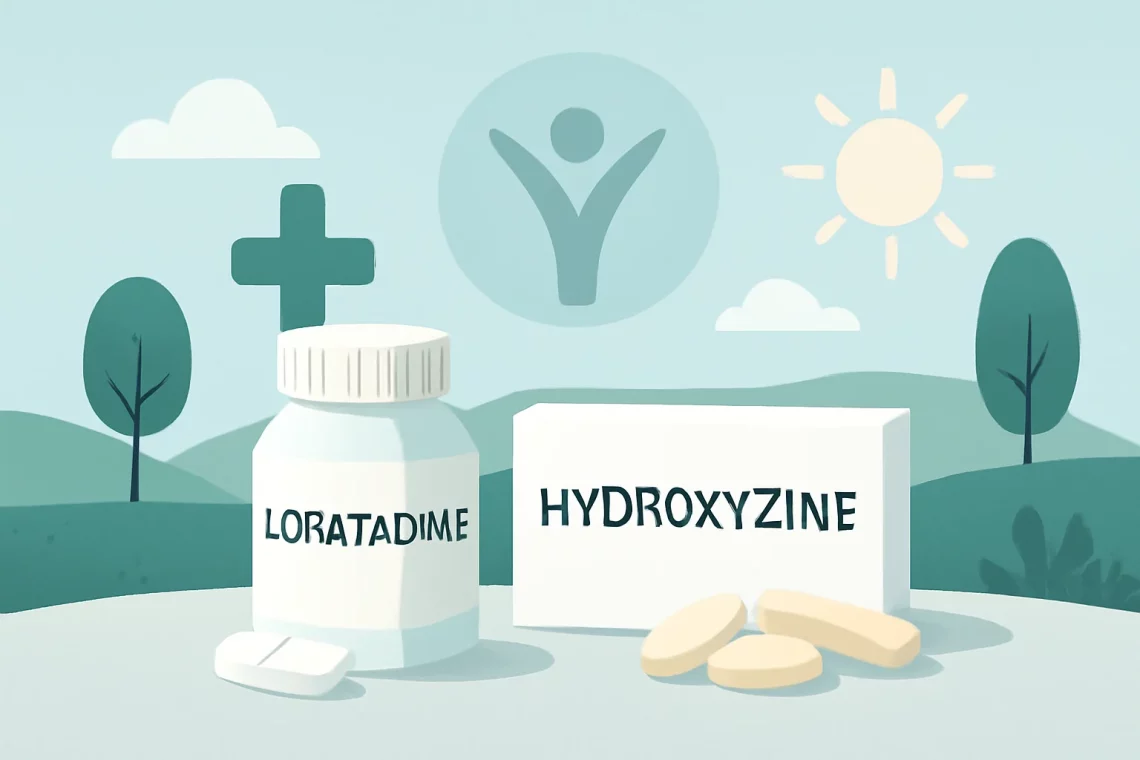
Loratadine vs Hydroxyzine: Which Allergy Medication Is Right for You?
Loratadine and hydroxyzine are two widely used antihistamines that serve different purposes in the realm of allergy and anxiety treatment. As individuals seek relief from allergic reactions, hay fever, or anxiety, understanding the differences and similarities between these two medications becomes crucial for making informed decisions. Both drugs are effective in alleviating symptoms associated with allergies, but their mechanisms of action, side effects, and usage guidelines vary significantly.
While loratadine is often preferred for its non-drowsy effects, hydroxyzine is known for its sedative properties and is frequently used in cases where anxiety relief is also needed. This article aims to explore the characteristics, uses, and potential side effects of each medication, helping readers to grasp the important distinctions and considerations when choosing between loratadine and hydroxyzine.
In a world where allergies and anxiety are prevalent, having a clear understanding of these medications can empower individuals to take control of their health and well-being. Knowledge about how these antihistamines work can lead to better management of symptoms and improved quality of life.
Understanding Loratadine
Loratadine is a second-generation antihistamine that is commonly used to relieve allergy symptoms such as sneezing, runny nose, and itchy eyes. Unlike first-generation antihistamines, loratadine is designed to minimize drowsiness, making it a popular choice for individuals who need to remain alert throughout the day. This non-drowsy characteristic is primarily due to its ability to cross the blood-brain barrier less effectively compared to its predecessors.
The medication works by selectively blocking peripheral histamine H1 receptors, which are responsible for the symptoms associated with allergic reactions. By preventing histamine from attaching to these receptors, loratadine effectively reduces the body’s allergic response. It is available in various forms, including tablets, orally disintegrating tablets, and syrup, allowing for flexible dosing options depending on the user’s preference and age.
One of the significant advantages of loratadine is its long duration of action. A single dose can provide relief for up to 24 hours, which is particularly beneficial for those suffering from chronic allergic conditions. Many users appreciate the convenience of once-daily dosing, as it simplifies their medication regimen.
However, while loratadine is generally well-tolerated, it may cause some side effects in certain individuals. Common side effects include headache, dry mouth, and fatigue. Although serious side effects are rare, individuals with liver impairment should use loratadine cautiously, as the drug is metabolized in the liver.
Given its efficacy and favorable profile, loratadine has become a go-to option for individuals seeking relief from allergic symptoms without the sedative effects commonly associated with first-generation antihistamines. Its non-drowsy formulation makes it particularly appealing for those who lead active lifestyles or require focus for work or study.
Exploring Hydroxyzine
Hydroxyzine is another antihistamine, but it belongs to the first generation of this class of drugs. Unlike loratadine, hydroxyzine is known for its sedative properties, making it an effective option for treating anxiety and tension as well as allergy symptoms. Its ability to cross the blood-brain barrier more readily means that it can produce calming effects, which is beneficial for individuals dealing with anxiety disorders or those requiring preoperative sedation.
The mechanism of action for hydroxyzine revolves around its ability to block both H1 receptors and certain neurotransmitter receptors in the brain. This dual action not only alleviates allergic symptoms such as itching and rashes but also helps in reducing anxiety and promoting relaxation. Hydroxyzine is often prescribed for conditions such as generalized anxiety disorder, insomnia, and even for short-term management of anxiety before surgery.
In terms of administration, hydroxyzine is available in various forms, including tablets, capsules, and syrup, and it is typically taken multiple times a day due to its shorter duration of action compared to loratadine. Patients may experience relief from allergy symptoms as well as a reduction in anxiety levels, making hydroxyzine a versatile medication in certain clinical scenarios.
However, the sedative effects of hydroxyzine come with a downside. Users may experience drowsiness, dizziness, dry mouth, or blurred vision, which may interfere with daily activities. As such, it is essential to avoid operating heavy machinery or driving until the individual knows how hydroxyzine affects them. Additionally, caution is advised for individuals with a history of substance abuse or those taking other central nervous system depressants, as the sedative effects can be amplified.
In summary, hydroxyzine serves as a valuable tool for managing both allergy symptoms and anxiety, but it is essential for users to be aware of its sedative properties and potential side effects.
Comparing Effectiveness and Uses
When comparing loratadine and hydroxyzine, it’s essential to consider their effectiveness and intended uses. Loratadine is primarily utilized for allergy management, making it suitable for individuals with seasonal allergies or chronic allergic rhinitis. It provides targeted relief from sneezing, itching, and other symptoms without causing significant drowsiness.
On the other hand, hydroxyzine serves a dual purpose by addressing both allergic reactions and anxiety. Its sedative effects make it particularly advantageous for individuals who need anxiety relief while also dealing with allergic symptoms. For instance, a person experiencing anxiety-induced itching may find hydroxyzine more beneficial than loratadine, as it can help alleviate both issues simultaneously.
Another factor to consider is the onset of action. Hydroxyzine typically works more quickly than loratadine, providing relief within 30 minutes to an hour, whereas loratadine may take a couple of hours to reach its peak effectiveness. This rapid onset can be crucial for individuals needing immediate relief, especially during acute allergic reactions or anxiety episodes.
Despite their differences, both medications have a solid safety profile and are widely prescribed. However, choosing the right medication depends on the individual’s specific symptoms, lifestyle, and the potential for side effects. For instance, someone who requires a non-drowsy option for daily use may prefer loratadine, while another individual seeking relief from anxiety along with their allergy symptoms may find hydroxyzine more suitable.
In conclusion, the effectiveness of loratadine versus hydroxyzine largely depends on the user’s needs and the nature of their symptoms. Both medications have their place in managing allergies and related conditions, and understanding their differences can help individuals make informed choices about their treatment options.
Potential Side Effects and Considerations
As with any medication, both loratadine and hydroxyzine come with potential side effects that users should be aware of. Understanding these side effects is crucial for making informed decisions about which medication may be more suitable for individual needs.
Loratadine is generally well-tolerated; however, some users may experience headaches, dry mouth, or fatigue. Serious side effects are rare, but individuals with liver problems should consult a healthcare provider before using loratadine, as it is metabolized by the liver. Additionally, while loratadine is less likely to cause drowsiness, some individuals may still experience mild sedation, which may vary based on personal sensitivity to the medication.
In contrast, hydroxyzine is known for its sedative effects, which can lead to drowsiness, dizziness, and dry mouth. While these effects can be beneficial for those seeking anxiety relief, they can also pose risks, especially for those who need to remain alert. Individuals taking hydroxyzine should avoid activities that require full attention, such as driving or operating machinery, until they understand how the medication affects them.
It is also important to consider potential drug interactions. Hydroxyzine may interact with other central nervous system depressants, leading to increased sedation. Similarly, individuals taking multiple medications should consult healthcare professionals to ensure there are no contraindications or interactions that could lead to adverse effects.
Ultimately, the choice between loratadine and hydroxyzine should involve careful consideration of the individual’s symptoms, lifestyle, and potential side effects. Consulting a healthcare provider can provide personalized advice and ensure the selected medication aligns with the individual’s health needs.
**Disclaimer:** This article is for informational purposes only and does not constitute medical advice. Individuals should consult their healthcare provider for any health-related concerns or before starting any new medication.




